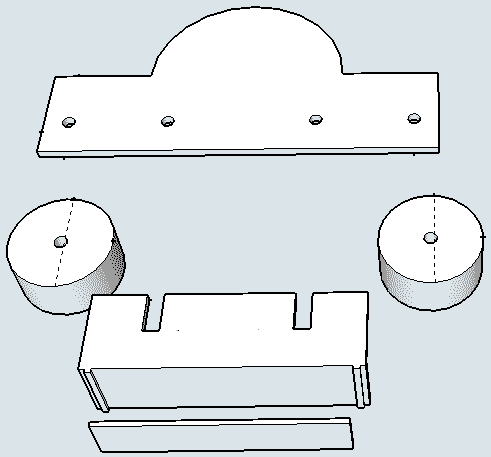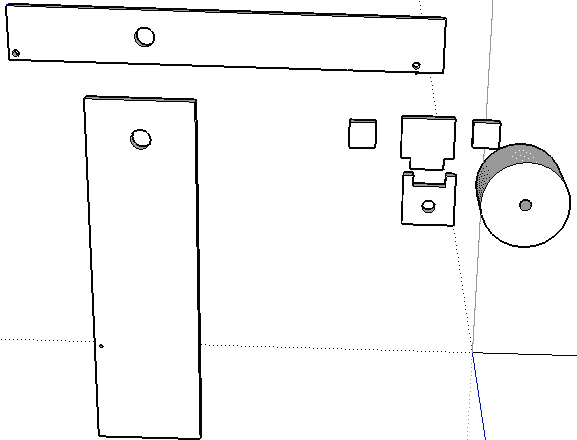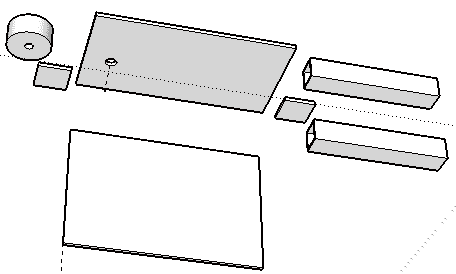|
|
|||||||
| The Newbies Arena Are you new to knife making? Here is all the help you will need. |
 |
|
|
Thread Tools | Display Modes |
|
#31
|
||||
|
||||
|
On the platen you would use pyroceram which is a kind of ceramic and is available from Darren Ellis. You definitely would not use ordinary glass but hardened steel is possible except that the pyroceram will out last the steel many times over. Be sure to put a 'foot' at the base of the platen to support the glass no matter what method you use to attach the glass to the platen.
No, a router controller will not work for a belt grinder. All such controls are basically just dimmer switches, suitable only for fractional horsepower motors..... |
|
#32
|
||||
|
||||
|
I figured as much on the router motor. Oh well. It's looking like Pulleyville here I come.
On the Platen I used Google Sketchup to mock this up. It's using 4" Idler wheels. Trying still to cut cost in the hopes that I can find a DC motor. Would using 4" wheels be a problem. It will be easy to change if so. I left a 1/4" of play between the foot and header on the platen rest 
|
|
#33
|
||||
|
||||
|
4" wheels probably won't be a problem but they are larger than most platens would use. Mine has a 3" wheel on one end and a 2" on the other. This gives you access to more wheel sizes for grinding different curves.
You just need a foot on one end of the platen. Having two means the glass lenth has to be very close to correct to fit and that might cut down your options when you go to buy glass. The foot needs to be the same thickness as the glass or almost the same. My foot is attached with a couple of screws but some people use steel pins. Cutting the foot into the platen face just adds to your machining costs ... |
|
#34
|
||||
|
||||
|
Thats a good point about the wheel sizes.
the header and foot weren't going to be machined. I should have pointed that out. I had planned on using some 1/8" steel since the platen is 3/16". Is that not close enough? I had planned also on welding it in place. But I can see it being a consumable area so that may not be the best. I'm thinking probably screws now. The mount for the platen is only 10" long. Because I was planning on using the 9" Platens. Should this be bigger? Would it be better to have it bigger if I plan on making larger than 9" knives? I had thought of going bigger. I thought it would be overkill but "Not Knowing" is just that. One other thing I am going to make this a pivoting Platen for a more versatile work area. Last edited by squigly1965; 02-09-2010 at 01:23 PM. |
|
#35
|
||||
|
||||
|
I wouldn't weld the foot as it might warp the platen. Make the foot the same thickness as the glass, the belt will quickly 'adjust' the thickness of the foot as needed.
No commercially available grinder that I know of have more than a 9" platen, most have less, but that doesn't mean you can't have one if you can build it. Probably not necessary though as lots of makers make knives that are more than 9" long without having platens that size. What happens if you want to make an 18" knife? The majority of platen work (mine, anyway) is done across the platen. The long direction of the platen is used for tapering tangs or flattening bolsters and guards and sometimes small blades. For many knives, working lengthwise on the platen just isn't practical, even on short blades, due to the presence of plunge cuts or integral guards and other features found beyond the border of the cutting area of the knife. Don't over think at this point. After you use the grinder for a while you'll want to add to it or redesign some of it anyway, no matter how much you try to make it perfect right now..... |
|
#36
|
||||
|
||||
|
oh yea I didn't take the epoxy thickness in to account either I know it should be thin but it will raise the platen some. But yea the 9x2 from Ellis was the one I was planning on
ok here's some more Pix of my design. This first one is The Tension and Tracking Arm. Something I was wondering. Does the Idler here need to be crowned? After doing some reading. It seems crowning has little effect on the tracking of the belt. And supposedly puts extra stress on the center of the belt. Thats just what I read IDK that's why I'm asking  Next Is the base with the upright and tubes for the Tooling arm and Work rest. I'm going to be using a Jack drive and step pulleys. I have a flange Bearing for it I think. I forgot to check the size but I'm pretty sure it was a 3/4" as well  Any comments or questions I'm game. I was planning on using 3/8" steel on all the parts that I can. Anyone see a problem with using it. Last edited by squigly1965; 02-09-2010 at 03:31 PM. |
|
#37
|
||||
|
||||
|
Every one I've ever read about who used an uncrowned idler wheel had significant tracking problems. I've seen tracking problems corrected by adding a couple of turns of electrical tape to the center of an uncrowned idler. I'd use a crowned wheel (in fact, I do).
3/8 is quite heavy, probably much more than absolutely necessary for anything but the base. I don't see where the extra weight would be a problem though and it likely could be a benefit (the KMG is very heavy and very smooth I hear). So, use what you have ... |
|
#38
|
||||
|
||||
|
Sounds good. Like I said i read about it and wanted some real world input on it.
The new steel I'm buying is some 2.00" square tube and 1.5" square tube for the tool arm and work rest and mount tubes And a piece of 3" x3" angled that is 3/16 thick using that for the platen. Wonder if I should use thicker? I had planned on welding in some supports but that might warp it. Maybe I could just weld the supports to the side and not to the platen back. Or I could just buy a thicker one |
|
#39
|
|||
|
|||
|
Hi, squigly1965,
I would like to offer different food for thought. I feel a variable speed grinder is worth the hassle especially for new makers. It lets you get the speed where you're comfortable and have control. Any AC brushed motor will work with variable speed, examples are drills, saws, vacuum motors, and the router you mentioned. The main thing is to have a controller that will handle the amps the motor needs, not a Habour Frieght model. For me the biggest downside is at the power required, they are all loud. I have used them all because it's what I had. Far from ideal, but they will work. DC motors are the way to go. To just go and buy a new Lesson or Bodine isn't an option, but that isn't the only choice. You are looking for any permanent magnet motor. Most electric lawnmowers are 1 to 2 hp DC motors. They can be found at yard sales for 10 or 20 dollars, Some floor buffers have a DC motor. Some of the new junk oiless air compressors have a DC motor. When the compressor gives up the motor is still good and you have the tank to build your forge. They all have a retifier to run on standard 120 volt AC current. When you tke them apart, save the rectifier. It already has the amp capacity for the motor. All that is needed then is a potentiometer that will handle the amps. Look for something in the 15 to 20 amp range. Not laying around everywhere, but there out there. When your hitting the yard sales for a mower. also look for a Variac. If you have to buy one off of ebay, you might as well just buy a DC controller, but make sure it has the amp rating to carry you motor. If for any reason you want to reverse it, like a disc grinder, you just put in a double throw double pole switch, and it's reversable. I would also like to throw out a completly different possibility. A belt grinder is the best method for grinding blades, but as you have seen, expensive for even the cheapest or homemade and it's not all your going to need to make a knife. Plus on a tight budget, 50 or 60 dollars for more belts is not always easy. An option is a stone wheel bench grinder and learn to hollow grind. Far from ideal, but it will get you to making knives inside your budget, and you will still use the bench grinder in your shop after you have a belt grinder. For $400.00 you can get a bench grinder and a dressing wheel to keep the coners of the stone square for clean plunges, a cheap drill press, a 4x36 belt sander with a 6 inch disc, a small vise, some files and drill bits, and learn to make knives. If you find any of it used, you'll even have money for some good steel. |
|
#40
|
||||
|
||||
|
I don't have any experience with the DC motors, but one thing that hasn't been mentioned but has been discussed in past threads is that there is often a loss of torque with changes in speeds. That may not be the case with a treadmill motor, but then again you can throw away a lot of money taking gambles on what might work and what might not.
Bottom line, if you are on a budget there is more than one way to make a knife. If you are serious about knifemaking and in it for the long haul, sooner or later you are going to spend the money on a better quality 2x72 belt grinder. If you do it later, you're more than likely going to spend a lot of money to get by, and be frustrated in the process. |
|
#41
|
||||
|
||||
|
well too bad I couldn't find a way to power this short of a multi battery set up . As batteries are not an option. You lean in to you grinder with one of these motors and your batteries are gone in no time. Look how fast a starter will drain a car battery.
4 HP 24 VDC ELECTRIC MOTOR 45 AMPS NO LOAD 140 AMPS FULL LOAD 8000 RPM FULL LOAD 32 INCH POUND OF TORQUE ?? DIAM. X 1 ?? SHAFT WITH KEYWAY MOTOR DIMENSION 4? DIAM. X 7 ?? now if I could get a motor to turn an alternator to turn this motor then I'd be in business. Still need a battery for load draws though I do have I do have 2 wheel grinders. 1 a Craftsman bench top and the other an 8" Jet with it's own stand. I have not been able to use either to my advantage when it comes to knife making. If was doing a lot of stock removal I suppose for the rough shape I could use them. So far though I've shaped them pretty close under the hammer use files. As they have have way more precision for me I am planning on using a pulley set up for my variable speeds. we had something like these on the sewing machines at my old job http://www.agrisupply.com/product.asp?pn=20879 The were used for timing with the conveyor belt. I could probably use one of these on the motor and a step pulley. Just need to figure a way to have either the motor or the Step pulley move to keep alignment. It would give me fine tuning on speed. they aren't too bad of a hassle to deal with. but using 2 of them would be Last edited by squigly1965; 02-10-2010 at 10:45 AM. |
|
#42
|
||||
|
||||
|
Some people mount the motor to a piece of plywood with a hinge on it. Once they get the motor aligned, they anchor it down. The weight of the motor keeps tension on the belts (although I have seen a turnbuckle added on some set-ups to increase tension). When it comes time to change pulley diameters to increase or decrease speed, it's just a matter of lifting the motor on the hinge. Alignment is maintained.
|
|
#43
|
||||
|
||||
|
That is true if I were to use (2) step pulleys or (2) adjustable pulleys
but if I use (1) step pulley and (1) adjustable pulley. Moving the belt to another step would take it out of alignment. This is the setup I was referring to in my previous post and actually now that I think of it Using (2) adjustable pulleys probably wouldn't be too bad. And it would give me very good control over the speed |
|
#44
|
||||
|
||||
|
The amount to which the belts are out of alignment by switching among the 2 step pulleys is not big deal, provided proper tension is maintained so you don't get any vibration. I have 3 step pulleys on my drill press, and there is no problem changing from highest to lowest speeds.
|
|
#45
|
||||
|
||||
|
you know. I knew that. I dont know why I didn't, but I knew that. Man I had a helluva brain fart.
Thanks for jogging the memory. Thinking of getting the Power Twist Link Belt. Wonder how the belt would handle the adjustable pulleys. I guess one way to find out |
 |
| Tags |
| blade, forge, hobby, knife, knife making, knives, supply |
| Currently Active Users Viewing This Thread: 1 (0 members and 1 guests) | |
|
|
 Similar Threads
Similar Threads
|
||||
| Thread | Thread Starter | Forum | Replies | Last Post |
| Bench sander/grinder | samlieblich | Tool Time | 1 | 04-09-2005 01:06 AM |
| grinder or sander? | Ellie | The Newbies Arena | 3 | 08-11-2004 09:14 PM |
| what kind of oil for surface grinder? | tmickley | Tool Time | 11 | 02-22-2004 01:13 PM |
| grinder or sander?? belt or disc?? | CAW | Tool Time | 11 | 11-19-2003 06:12 PM |
| surface grinder/Drum Sander | beebee58 | Tool Time | 4 | 08-21-2003 12:53 PM |